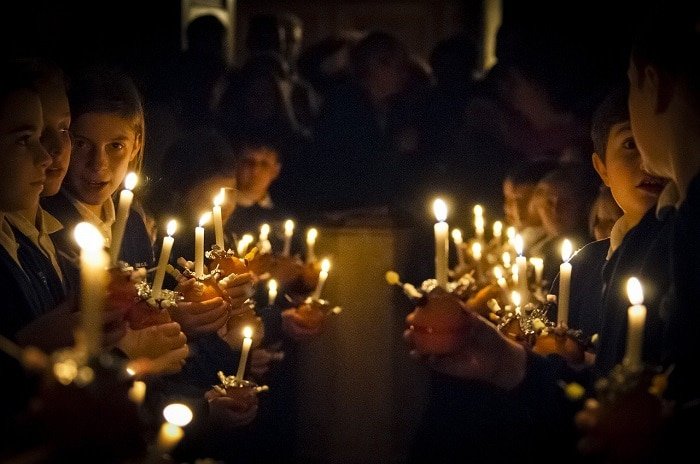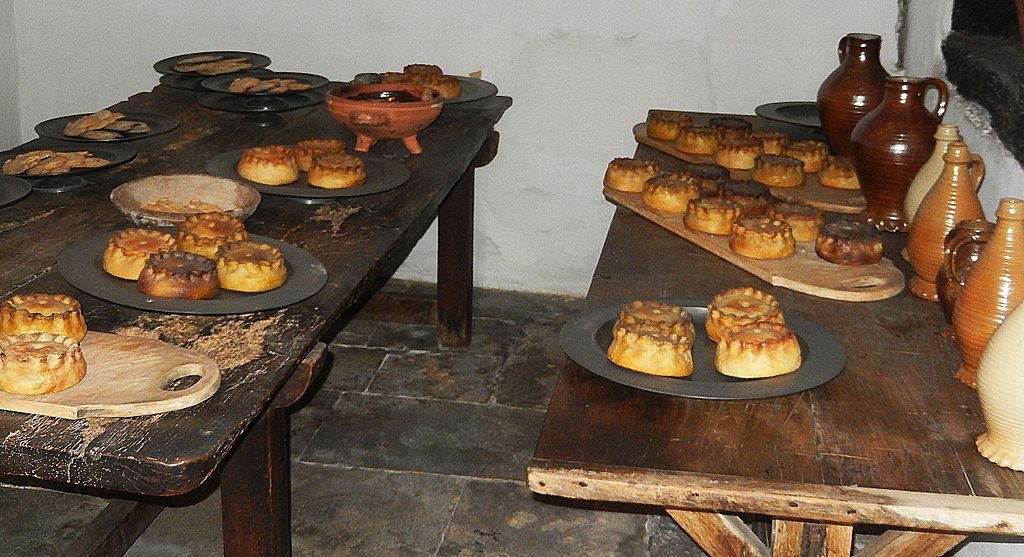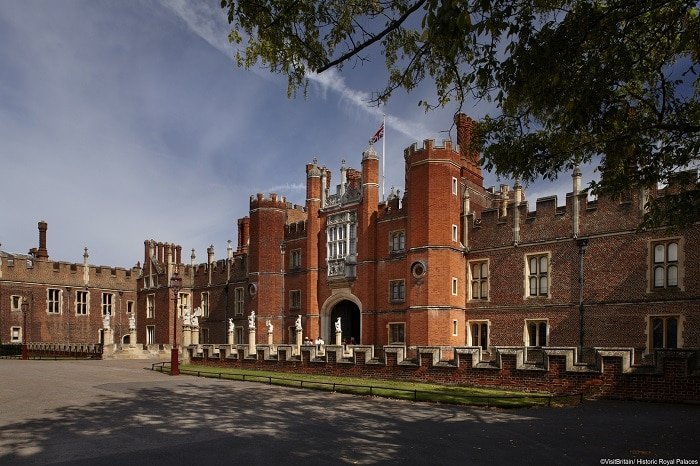
Many of our modern Christmas traditions would have been unheard of during the reigns of Henry VIII and his Tudor brethren. Don’t expect to see a Christmas tree, for one thing. The religious nature of the holiday took precedence on December 25th, but there was a sprawling 12 days of celebrations so plenty of time for feasting and making merry too. This year, we take a look at a Tudor Christmas and all that it would entail.
When was the Tudor Period?

The Tudor era is one that continues to capture our imaginations, and with good reason. Henry VIII and his many wives, the lengthy reign of Elizabeth I, the oh-so-short and tragic term of Lady Jane Grey. The rise of the Church of England and an ongoing back and forth with Catholicism. This was a period of new exploration, tumultuous change, and lavish displays of wealth.
The Tudor period began in 1485 with Henry VII ascending to the throne of England and Wales. After his death in 1509, son Henry VIII ruled until 1547. Then followed six years under the child king Edward VI, the ill-fated Nine Days Queen (Jane Grey), and five years with Mary I, aka Bloody Mary. Elizabeth 1 took the throne in 1558 and the Tudor era ended with her death in 1603.
For the purposes of this piece, we are looking mostly at Christmas traditions during the reigns of Henry VIII and Elizabeth I. Although he ruled for 24 years, Henry VII was not always the most popular king and had quite a reputation for frugality. When his young son took the crown, he put a good many changes into place. The dashing and headstrong 18 year old Henry spent lavishly on Christmas celebrations to help cement his status and showcase the opulence of England to the rest of Europe. If you have watched the wonderful Lucy Worsley’s 12 Days of Tudor Christmas, you will know that while Henry VII spent just £12,000 in one entire year of his reign, his son splashed out an extravagant £7,000 on just his first Christmas as King. So let’s find out what they were all up to during the festive season.
Twelve Days of Christmas?
In later centuries, people would find themselves perhaps with only Christmas Day to celebrate and then straight back to work. But not for those in the Tudor-era. The Christmas celebrations would last an entire 12 days. That’s right. The 12 Days of Christmas isn’t just a song. Work would come to an end on Christmas Eve and would not resume until after Epiphany (6th January). In some cases, it might not resume until Plough Monday, the first Monday after Epiphany.
Of course, in reality this downtime would only apply to certain professions. After all, someone still had to feed and care for the livestock. And those who worked in the kitchens of the Royal court definitely didn’t get to enjoy a break. But all other types of business would cease.
To emphasize this, one form of important decoration in the household was adding greenery to the spinning wheel. Boughs of greenery woven between the spokes were a symbol that work had stopped. Decorations would be added elsewhere in the house on Christmas Eve. Holly, ivy, mistletoe, and herbs such as rosemary would all be intertwined and draped across windows and down staircases. There may not have been a Christmas tree but these natural garlands must have smelled wonderful.

A Time for Religious Devotion
Christmas was first and foremost a time for religious devotion. Even though we may envision Henry VIII’s court as one of feast, dance, and romantic intrigue, he expected strict observance of the various religious dates during this time. That began with a midnight mass on Christmas Eve. December 25th allowed little time for merriment. People typically said mass three times on Christmas Day.

Boxing Day, known by its religious name, St. Stephen’s Day, was a day for charitable giving. On 28th December, another mass was said for the Feast of the Holy Innocents, commemorating the infants killed by King Herod. New Year’s Day was the Feast of the Circumcision, and finally on 6th January, Epiphany drew the festive season to a close.
Yet there was some room for mayhem even within the church. In many cathedrals, the choirboys would elect one of their own to serve as the Boy Bishop. From the 6th to the 28th of December, he would wear the robes of a bishop and even conduct some services. It proved quite popular and was practised through much of the Middle Ages and into the Tudor era. Henry VIII abolished the custom in 1542, believing it was making a mockery of him as head of the Church of England. Mary revived it during her reign, but Elizabeth then put an end to it. Nevertheless, a few cathedrals continue the custom to this day.
And a Time for Making Merry
Worried that all these masses left little time for partying? Fear not. After all, remember we said that Henry VIII enjoyed spending at this time of year.

Presiding over the celebrations was the Lord of Misrule, another throwback to the Middle Ages and even the Roman feast of Saturnalia. Similar in some ways to the concept of the Boy Bishop, this seems to have been a feature of all levels of society, from the Royal Court to the village. A member of court or a commoner within the village was appointed Lord of Misrule, a mock leader for the festivities. He would oversee the entertainment and generally make sure that chaos and fun abounded. Henry VII reputedly loved this tradition, as did his grandson, Edward VI. Elizabeth I, however, was less fond of their raucousness and the mayhem that ensued. She discouraged the habit and it eventually died away.
The 12 days of a Tudor Christmas allowed for plenty of eating, drinking, and making merry. With plays, music, and mummers, a good time was had by all. People traditionally exchanged gifts not at Christmas but on New Year’s Day, and if you wanted to curry favour with the King, he loved presents.
But what about New Year’s Eve? Well, people celebrated it a little differently to how we do now. It just wasn’t that big a deal. Far more important was the Twelfth Night Feast, complete with wassailing, banquets, music, and the giant Twelfth Night Cake.
Afterwards, it was time to take down the decorations and life returned to normal. Many people, myself included, still make sure that the decorations come down on or before the 6th January.
Food?
Everyone loves food at Christmas. However, in Tudor times, the period leading up to Christmas was one of fasting. No meat allowed. Christmas Eve’s fast was particularly strict, with no eggs, cheese, or meat to be consumed. Of course, if you were poor, chances are you rarely got to enjoy these anyway. And, if you were rich, you would more than make up for it during the coming festivities.
If you were lucky enough to be celebrating at Court or in a wealthy household, you could enjoy a vast array of pies, meats, and sugary sweets. Elizabeth I had a strong sweet tooth, and carefully crafted sugar and marzipan treats adorned both her table and that of her father. Mince pies were a feature of the festive table, although these were the traditional kind that featured meat mixed with spices and dried fruits. The 13 ingredients used to fill the pies represented Christ and his 12 apostles.

But at the centre of the table would be a wild boar, marinated in wine and spices, stuffed, and boiled. You might also see a peacock or a swan, stuffed and cooked, and then resewn into its feathers to look lifelike. Extravagance was the marker of a Tudor feast, not just in quantity of food, but also in creativity. This was the era of the cockenthrice–the front end of a piglet stitched to the rear end of a turkey– and the original turducken, a roast of several birds, stuffed within each other. All was washed down with gallons of wine, ale, and mead.
Other Christmas Traditions
The Tudor Christmas included several other traditions that we would recognise today in one form or another.
Making an appearance at some point in Elizabeth’s reign was plum pottage. Historians believe this to be an early precursor to the modern Christmas pudding. Be warned though that early descriptions sound nothing like what we enjoy with brandy butter. It’s described as “a sort of soupy stew based on beef, raisins, currants and bread, with spice if you could afford it.” I’ll skip that, I think.
The Yule Log (of the wooden variety rather than chocolate) was a throwback to the Norse invaders of centuries before. The log was decorated and hauled to the fireplace where it would be kept smouldering throughout all 12 days of Christmas. For good luck, many would keep some of it until the following year.
People have been singing Christmas carols since about 1426, although they used to accompany the songs with by dancing. Well-known carols that probably made an appearance during the 16th century include Good King Wenceslaus, The First Noel, and We Wish You a Merry Christmas, although they may have sounded rather different to what we now sing.

So there you have it – some of the magic of a Tudor Christmas. Do you think you’d be up for 12 days of raucousness tempered with going to mass? Or does it all sound too exhausting?


